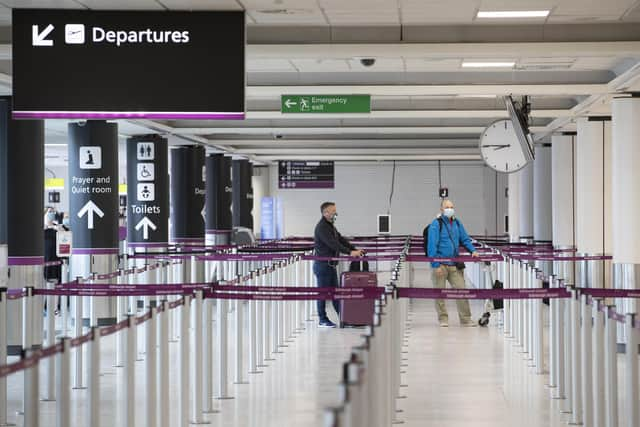End of furlough in Scotland: ‘I had no idea what would happen to my job’


Employed at a leisure business which has not reopened since the first lockdown, he had been on furlough for 16 months. The scheme has been due to end twice before – in October last year and this April – but was extended by the UK government.
"Every time furlough was due to come to an end, I never knew what was going to happen,” said Mr Coburn, who lives in Edinburgh with his wife and nine-year-old daughter. “It was very stressful. The owners of the business didn’t know whether they would be able to re-open, or if we would all be made redundant, then each time, furlough was extended and it gave us some more time.”
Advertisement
Hide AdAdvertisement
Hide AdNow, the £66 billion scheme is finally due to be wound up after 18 months, ending on 30 September, amid fears that many businesses could be forced to jettison staff. Mr Coburn decided to leave his employer voluntarily last month, after finding a new job in a different industry.


"It was a shame to leave, but I had my family to think of,” he said. “I had no idea what would happen at the end of September, if I would still have a job or not, so I had no choice.”
At its peak, 8.9m people across the UK were on the Coronavirus Jobs Retention Scheme – the formal name for furlough. The latest figures from the Office for National Statistics show that around 1.9m people - seven per cent of staff – were on full or partial furlough in early August. In Scotland, the number of furloughed jobs fell to 173,100 at the end of May, down from 275,700 in April, with the figure believed to have fallen much further now.
Business leaders described the scheme as a “lifeline”, especially in sectors such as events and travel which are not yet back to normal.
Andrew McRae, policy chair for the Federation of Small Businesses Scotland, said: “Though far fewer workers and firms in Scotland are using the scheme now than at its height, the winding down of this initiative will force some firms to make very tough decisions.
“More positively, however, unemployment is far lower now than many expected. The big challenge industry and government has is to ensure those that lose their jobs thanks to the pandemic can find work elsewhere in the economy. While previous economic shocks show that this is easier said than done, we must help the people and firms hit hardest by the last 18 months.”
Ewan MacDonald-Russell, head of policy at the Scottish Retail Consortium, said that nine per cent of UK retail staff are still currently on furlough, due to some stores still being closed, or operating on reduced hours as city centre footfall and trading continue below pre-pandemic levels and called for “decisive action”.
He said: “Whilst most restrictions have been lifted, the reality is sales have not rebounded, especially in town and city centres. That means many workers will be very nervously awaiting decisions from their employers on whether there will remain work for them.
Advertisement
Hide AdAdvertisement
Hide Ad"It is a stark reminder that whilst the scheme is ending, the uncertainty caused by the pandemic remains.”
Gillian Moore, associate in Shepherd and Wedderburn’s employment team in Glasgow, warned that companies would have to make difficult decisions over the coming weeks.
She said: “With furlough coming to an end, employers still making use of the scheme are having to ask themselves questions about the ongoing viability of their business, the number of staff they need, and what cost savings they need to make in order to give their business the best chance of long-term survival. Unfortunately, this means that some employers will be considering reducing staff head count by making redundancies, terminating contracts, and offering fewer or no hours to casual staff.
"Redundancies can be very costly, so many businesses will be weighing up whether it makes better financial sense to make redundancies now or absorb surplus staff costs for a time in the hope that business will improve.”
A survey from Advice Direct Scotland last month found that 35 per cent of Scottish workers were worried about the future of their jobs.
Karen Harvie, senior associate in employment law at Aberdein Considine in Edinburgh, said that the true number of redundancies made as a result of the pandemic would never be known. She warned that an increase in the number of settlements – where staff are paid off at a higher rate than basic redundancy, but sign an agreement waiving any employment rights in the future such as taking out an unfair dismissal claim – had rocketed in recent months. These layoffs will not be classed as redundancies, distorting the national statistics.
She said that furloughed employees need to begin conversations with their employers about the future.
"They need to be thinking about what they want to do, whether they want to try to negotiate reduced hours, or a pay cut - or if they want redundancy,” she said, adding that many small businesses with staff on furlough would never have had to deal with complicated HR issues before.
Advertisement
Hide AdAdvertisement
Hide Ad“Companies which are planning to make staff redundant at the end of the month will have to start preparing now as it is a complicated process. They will need to send out letters soon, if they haven’t already.”
However, it is not only small businesses which have relied on the furlough scheme.
Unions have voiced fears that struggling corporate giant Liberty Steel faces a “cliff edge”, risking thousands of jobs when the scheme ends next month, unless a new source of financing is found. About 70 per cent of the company’s workers – more than 2,000 employees – were supported by the government’s furlough scheme in the last month, including many in Scotland.
Business leaders are also concerned about what the end of the furlough scheme means for any future restrictions implemented by the Scottish Government. The scheme was financed by Westminster, meaning that if any Scotland-specific lockdowns are brought in, support will not be on offer.
Earlier this week, public health chief Jason Leitch alluded to “switching off” sections of society if coronavirus cases continue to rise.
Charandeep Singh, deputy chief executive of the Scottish Chambers of Commerce, said that the group had lobbied the UK Government to consider a scheme akin to Germany’s Kurzarbeit, where employers reduce their employees' working hours instead of laying them off. He told the Scottish Parliament's economy committee on Wednesday that a UK-wide furlough scheme should exist which can be employed as and when it is needed amid potential future lockdowns.
He told Scotland on Sunday: “Businesses are already consulting closely with their employees on plans to bounce back, return to the office and to support wellbeing and morale. This will include communicating with furloughed employees on what to expect, timelines for their return and updates on how their working routines and patterns may have changed.
“However, some businesses may not be able to bring all their employees back from furlough, especially if their sector is still limited by ongoing Covid restrictions. To support businesses still unable to fully re-open, the government should consider the creation of a contingency business support plan, particularly with the possibility of restrictions being re-imposed this winter.
Advertisement
Hide AdAdvertisement
Hide AdA spokesman for the Scottish Government said: “The furlough scheme has provided essential support to businesses and workers throughout the pandemic and is still needed as we move through recovery. Scottish Ministers have repeatedly called on the UK Government to ensure furlough remains in place for as long as it is required – if it is to be removed, the UK Government must clarify well in advance what further assistance will be in place to support jobs and necessary labour market transitions in sectors that are most deeply impacted by Coronavirus (COVID-19).”
Robert Coburn’s name has been changed
A message from the Editor:
Thank you for reading this article. We're more reliant on your support than ever as the shift in consumer habits brought about by Coronavirus impacts our advertisers.
If you haven't already, please consider supporting our trusted, fact-checked journalism by taking out a digital subscription.
Comments
Want to join the conversation? Please or to comment on this article.
